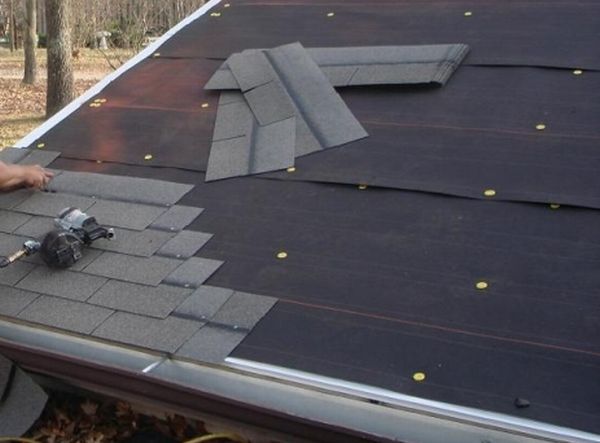Tar paper
Roofing felt or bitumen roofing membrane ( colloquially referred to as tar paper often wrong after ruberoid ) is impregnated with bitumen board, which serves as a moisture barrier in components. Partial is rolled into the roofing felt coarse sand, fine gravel or slate chippings, to achieve a higher abrasion resistance and UV resistance.
Invention
1842 appeared from the Neustrelitzer builder Friedrich Wilhelm Buttel the monograph Practical experience over Dornsche roofs together with a detailed description, cost calculation and drawing of such constructions, which give the same duration and greater tightness, and an appendix on the flat roofs at economic buildings. In it he described the first time the tarred roofing felt to cover classical flat roofs and can be therefore considered as probably the inventor.
Species
- The normal roofing felt is installed as a roofing membrane only overlapping and can thus hold no standing water.
- The weld path has a high bitumen content and is welded to a waterproof layer.
- Tar paper was used in the early 1970s and soaked in coal tar. This roofing felt is banned due to toxic substances.
Use
Main use is roofing felt as a second roof skin under roof tiles. In some cases it is used as the first and only roof skin for the coverage of simple wooden roofs of gazebos, equipment houses and the like. It is fastened with roofing nails on a wooden formwork. As diecutting Preolitschindeln they were for many years a roofing typically used in the GDR, which was used instead of roofing tiles or slates. These were soaked in the early 1970s in coal tar, which indeed turned out to be effective against moisture, but also as a carcinogen and therefore extremely health and environmentally hazardous. The tarred roofing felt is no longer manufactured by an EU-wide ban on use.
Welding the current path is used as a high quality, especially in roof constructions with standing water, thus particularly in the insulation of flat roofs. Both types are used in low earth or moist environments to form a moisture barrier, for example in brick basement walls between the layers of brick or large warehouse roofs and shopping malls.
The shelf life is indicated with about 7 years.
Material
Coal tar is considered due to its ingredients such as polycyclic aromatic hydrocarbons ( zBToluol or benzene ) as a carcinogen. Therefore, and because of the environmental load comes coal tar for decades in roofing felts no longer used. Since the early 1970s, bitumen or polymer bitumen used. Since roofing sheets are totally free of tar. Teerdachbahnen are no longer manufactured in Europe.
Disposal
Even today you can still find worldwide roofs of old industrial buildings and vacant warehouses, which are coated with teergetränkten roofing membranes. Due to the various, sometimes toxic substances bituminous, but especially tarred roofing felt is a hazardous waste and require proper disposal.









